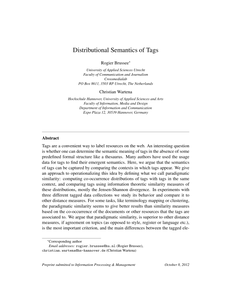Preprint submitted to Information Processing & Management Tags are a convenient way to label resources on the web. An interesting question is whether one can determine the semantic meaning of tags in the absence of some predefined formal structure like a thesaurus. Many authors have used the usage data for tags to find their emergent semantics. Here, we argue that the semantics of tags can be captured by comparing the contexts in which tags appear. We give an approach to operationalizing this idea by defining what we call paradigmatic similarity: computing co-occurrence distributions of tags with tags in the same context, and comparing tags using information theoretic similarity measures of these distributions, mostly the Jensen-Shannon divergence. In experiments with three different tagged data collections we study its behavior and compare it to other distance measures. For some tasks, like terminology mapping or clustering, the paradigmatic similarity seems to give better results than similarity measures based on the co-occurrence of the documents or other resources that the tags are associated to. We argue that paradigmatic similarity, is superior to other distance measures, if agreement on topics (as opposed to style, register or language etc.), is the most important criterion, and the main differences between the tagged elements in the data set correspond to different topics
DOCUMENT

In this study, we used electroencephalography to investigate the influence of discourse-level semantic coherence on electrophysiological signatures of local sentence-level processing. Participants read groups of four sentences that could either form coherent stories or were semantically unrelated. For semantically coherent discourses compared to incoherent ones, the N400 was smaller at sentences 2–4, while the visual N1 was larger at the third and fourth sentences. Oscillatory activity in the beta frequency range (13–21 Hz) was higher for coherent discourses. We relate the N400 effect to a disruption of local sentence-level semantic processing when sentences are unrelated. Our beta findings can be tentatively related to disruption of local sentence-level syntactic processing, but it cannot be fully ruled out that they are instead (or also) related to disrupted local sentence-level semantic processing. We conclude that manipulating discourse-level semantic coherence does have an effect on oscillatory power related to local sentence-level processing.
LINK
This study provides ERP and oscillatory dynamics data associated with the comprehension of narratives involving counterfactual events. Participants were given short stories describing an initial situation ("Marta wanted to plant flowers in her garden...."), followed by a critical sentence describing a new situation in either a factual ("Since she found a spade, she started to dig a hole") or counterfactual format ("If she had found a spade, she would have started to dig a hole"), and then a continuation sentence that was either related to the initial situation ("she bought a spade") or to the new one ("she planted roses"). The ERPs recorded for the continuation sentences related to the initial situation showed larger negativity after factuals than after counterfactuals, suggesting that the counterfactual's presupposition - the events did not occur - prevents updating the here-and-now of discourse. By contrast, continuation sentences related to the new situation elicited similar ERPs under both factual and counterfactual contexts, suggesting that counterfactuals also activate momentarily an alternative "as if" meaning. However, the reduction of gamma power following counterfactuals, suggests that the "as if" meaning is not integrated into the discourse, nor does it contribute to semantic unification processes.
LINK